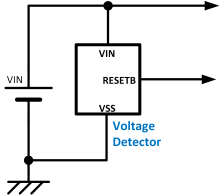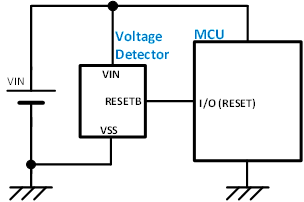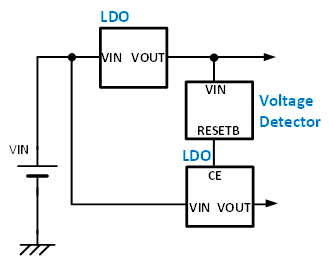The voltage detector is an IC that monitors the voltage of power supply line to output a detected signal when the voltage falls below or exceeds the setting voltage. The voltage detector is also called VD (abbreviation of voltage detector), reset IC, or supervisor, etc.
The basic relationship between input (monitoring voltage) and output of voltage detector is shown below.
| Monitoring voltage | Output |
|---|---|
| Release voltage or more (detect voltage + hysteresis) | “H” |
| Detect voltage or less | “L” |
Use application of voltage detector
1.Monitoring of battery / power supply voltage
The voltage detector monitors the power supply line. If the voltage of power supply line becomes abnormal, a signal is output to the following device. Transmitting the abnormal status to the following device judges the abnormal status or stops the operation of the system.
The voltage detector is also used for monitoring the voltage of battery. Detection of battery voltage drop by voltage detector is used for stopping the operation of system or display of voltage drop status, etc.

2.Reset of MCU / Power On Reset (POR)
For an MCU, operating voltage range is set.
The voltage detector monitors MCU's power supply line. If the voltage of power supply line becomes operating voltage or less, a reset signal is output to stop the MCU. The voltage detector is also utilized to operate the MCU after making sure the power supply line is turned ON.

3.Power supply sequence control
Some MCUs and modules require multiple power supplies such as main power supply and core power supply. For some devices, rise-up / rise-down sequence of each power supply is specified.
It is possible to monitor the power supply line using a voltage detector to start up / fall down the next power supply after rise-up / rise-down of a power supply line.
A power supply sequence can be easily created using this function.
